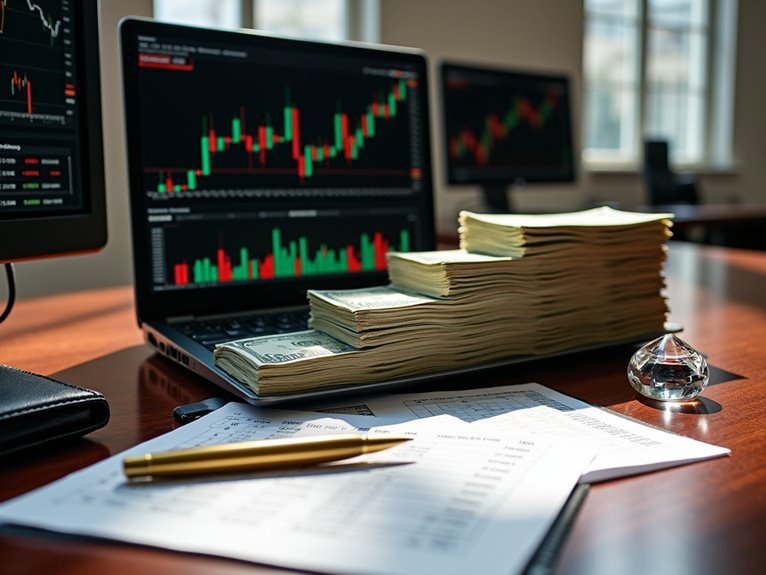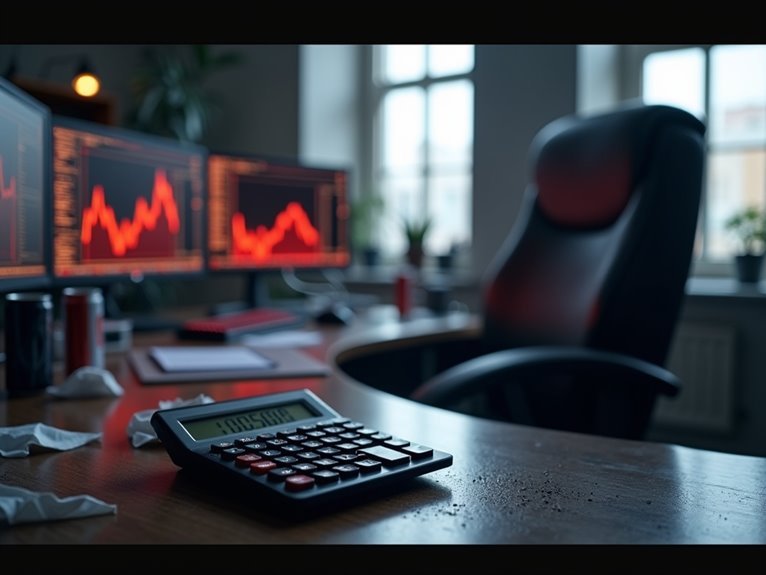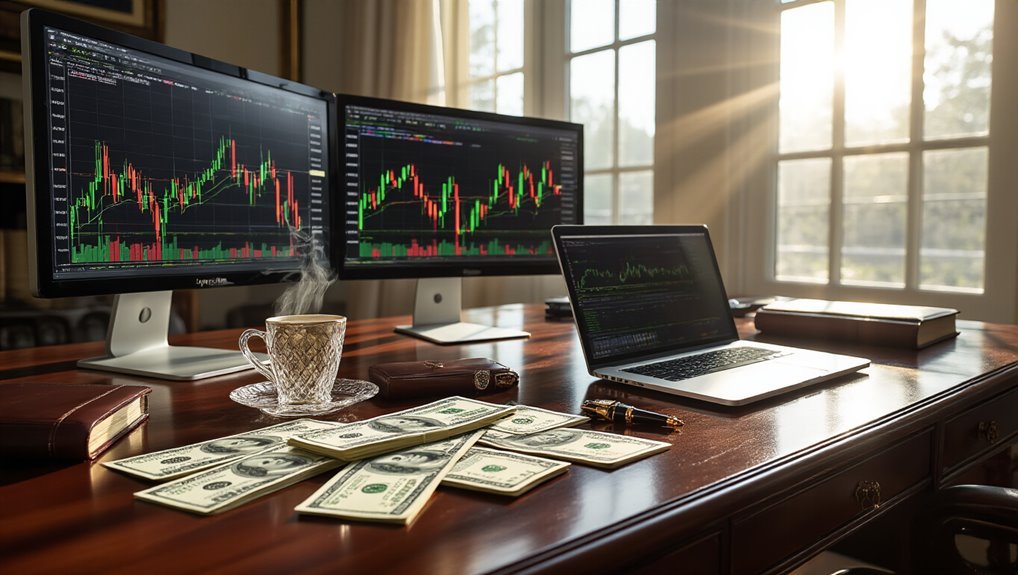Day traders with $100,000 in capital typically earn between $33 and $130 daily, representing 0.033% to 0.13% returns. Experienced traders often target around $400 per day, potentially generating $100,000 annually across 252 trading days. However, only 4% of day traders consistently earn a living from trading. Monthly expectations range from $1,000 to $4,000, though many face breakeven or losing months. Success depends heavily on risk management, trading style, and psychological discipline. The complete picture reveals additional factors that determine actual outcomes.
Daily and Monthly Earnings Expectations for $100K Trading Accounts

The numbers tell a straightforward story. With $100K, realistic daily earnings typically range from $33 to $130. That translates to 0.033% to 0.13% daily returns—modest but achievable.
With realistic expectations, $100K can generate $33-130 daily through consistent trading discipline and modest percentage returns.
Conservative traders target $500 daily. Aggressive ones shoot for $1,000. Most experienced traders aim for $400 to reach roughly $100K annually across 252 trading days.
Monthly expectations mirror these patterns. Successful traders earn $1,000 to $4,000 monthly—1% to 4% returns. The lower end suits conservative approaches. The higher end can support full-time trading. Professional day traders can earn significantly more, with disciplined professionals often exceeding $100,000 annually.
But consistency remains elusive. Monthly returns fluctuate wildly based on market conditions and skill execution. Many traders face breakeven or losing months during their learning curve. Only 10-30% of day traders maintain profitability over time, highlighting the challenging nature of sustained success.
Annual projections look promising for consistent performers: $12,000 to $48,000 yearly for those hitting monthly targets. However, most beginners earn far less initially. Some lose money outright. Using leverage to amplify returns increases both potential profits and associated risks.
The gap between expectation and reality stays wide. Implementing backtesting models can significantly improve performance by validating strategies before risking real capital.
Risk Management Strategies That Impact Your Profit Potential
While profit potential grabs headlines, risk management determines who survives day trading. Smart traders risk only 1-2% of their capital per trade. With a $100K account, that’s $1,000-$2,000 maximum loss per position.
Position sizing matters more than picking winners. Traders calculate share quantities based on stop-loss distance and account size. Volatile stocks get smaller positions. Stable conditions allow larger bets. This dynamic approach protects capital during rough patches. Implementing pyramid trading strategy can help scale profits gradually without taking on excessive risk. Following a trading plan is essential for maintaining discipline and avoiding emotional decisions that lead to excessive risk-taking.
Stop-loss orders are essential. About 88% of day traders use them to cap downside automatically. Trailing stops lock in profits while limiting losses. Proper placement prevents both catastrophic losses and premature exits.
Systematic strategies remove emotions from risk decisions. Discretionary approaches allow manual overrides but invite mistakes. Only 13% of day traders remain profitable after six months. Those who survive follow strict loss limits religiously. Breakout trading achieves a 30% success rate, making it one of the more reliable day trading approaches when properly executed.
Risk controls directly impact earnings. Conservative management preserves capital for future opportunities. Aggressive risk-taking might boost short-term gains but often leads to account destruction. Diversification across different sectors helps reduce exposure to any single market segment. Risk-to-reward ratios serve as another critical component of effective risk management alongside stop-loss levels and position sizing.
Trading Styles and Their Effect on Income Generation
Beyond protecting capital, trading style fundamentally shapes how much money day traders can realistically earn. Pure day trading requires constant monitoring. Stress levels spike. But profits come quickly when done right.
Scalping takes this further. Traders hold positions for seconds or minutes. They need lightning-fast execution and extremely liquid markets. The income potential? High. But it demands repetitive risk management without accumulating losses. Successful scalpers often identify supply and demand zones to execute high-probability trades with clear risk parameters.
Scalping demands split-second decisions and flawless execution, offering high income potential for those who master lightning-fast risk management.
Swing trading offers a different path. Positions last days to weeks. Less stress. Fewer transactions mean lower costs. However, overnight risk increases. Weekend gaps can destroy profits unexpectedly. Some traders utilize overnight trading sessions to adjust positions based on after-hours market movements. Swing traders need to identify more profitable setups to cover higher costs compared to intraday traders.
Position trading extends even longer. Weeks, months, sometimes years. It requires substantial capital to weather volatility cycles. Income realizes slowly but potentially delivers bigger payouts per trade. This approach emphasizes fundamental analysis and macroeconomic trends when evaluating long-term opportunities.
Each style demands different skills. Day trading needs quick decisions and often utilizes margin with leverage to magnify both profits and potential losses. Position trading requires deep analysis. The time commitment varies dramatically. Income patterns differ too. Frequent small gains versus larger, infrequent profits.
Reality Check: Success Rates and Common Challenges Traders Face

Numbers don’t lie when it comes to day trading success. Only 4% of day traders earn a consistent living. The statistics get worse from there.
Approximately 13% remain profitable over six months. But after five years? Just 1% sustain long-term success. That’s brutal math.
The attrition rate tells the real story. 40% quit within the first month. By three years, only 13% remain active. Most can’t handle the psychological pressure of constant losses.
Financial outcomes paint a grim picture. FINRA data shows 72% of day traders experienced losses in analyzed periods. During the pandemic, traders collectively lost $1.14 billion. Novice traders? They hemorrhaged $5 billion including transaction costs. Professional day traders can achieve returns of 2% to 6% daily when successful. Traders using leverage face a 70% chance of losing all their capital when short on funds.
Poor risk management kills 85% of traders in their first year. Even among proprietary traders, only 16% succeed. Just 3% earn over $50,000 annually. Trading success requires a $25,000 minimum capital and access to leverage for stock trading opportunities.
The market doesn’t care about your $100K starting capital if you lack discipline and strategy.
Frequently Asked Questions
What Tax Implications Should I Expect From Day Trading Profits?
Day traders face significant tax burdens on profits. Gains get taxed as ordinary income at rates up to 37%. No preferential treatment like long-term investments. State taxes add extra bite. Self-employment tax might apply if trading’s considered a business. Traders pay taxes the year gains realize—no deferral options. High earners face additional 3.8% investment tax. Qualifying for Trader Tax Status helps through deductions and mark-to-market accounting benefits.
How Much Capital Should I Keep Aside for Living Expenses?
Traders should maintain six to twelve months of living expenses in liquid savings, separate from trading capital. This cushion reduces stress and prevents poor decision-making driven by immediate income needs. The amount depends on personal risk tolerance and expense levels. For someone with $2,500 monthly costs, that means $15,000 to $30,000 set aside. Without this buffer, traders risk depleting funds during inevitable drawdowns.
Which Brokers Offer the Best Commission Rates for High-Volume Trading?
Interactive Brokers dominates high-volume trading with commissions dropping to $0.0005 per share for large traders. Fidelity and Schwab offer zero stock commissions, eliminating per-trade costs entirely. Webull matches with zero commissions plus competitive margin rates. Options cost around $0.65 per contract across platforms. Interactive Brokers’ Trader Workstation excels for active traders, while Fidelity’s Active Trader Pro provides superior research tools.
What Equipment and Software Do I Need for Professional Day Trading?
Professional day traders need high-performance computers with Intel i7/i9 or AMD Ryzen processors. Minimum 16GB RAM, preferably 32GB. SSDs are essential. Multiple monitors—24-27 inches with thin bezels—are standard equipment. Gaming monitors work best for chart clarity. Dedicated trading platforms provide real-time data and execution. Risk management software prevents disasters. High-speed internet is non-negotiable. Backup power systems protect against outages. Ergonomic setups matter during marathon sessions.
How Long Does It Take to Become Consistently Profitable?
Becoming consistently profitable in day trading takes years, not months. Only 13% of traders remain profitable after six months. The numbers get brutal: just 1% maintain profitability after five years. Most beginners lose money initially due to inexperience and steep learning curves. Around 40% quit within the first month. Those who survive the critical 3+ year period have considerably better odds of eventual success.
Conclusion
Day trading with $100K offers significant potential but harsh realities. Skilled traders might generate 1-3% monthly returns. That’s $1,000-$3,000 per month if everything goes right. Most don’t succeed. Statistics show 80-90% of day traders lose money. Risk management becomes critical. Position sizing, stop losses, and emotional control separate winners from losers. Trading styles matter too. Scalping demands different skills than swing trading. The math works on paper. Human psychology often doesn’t.



